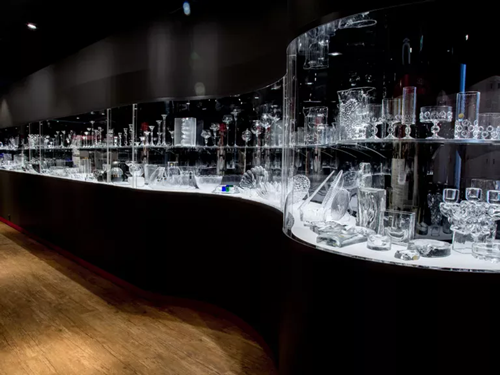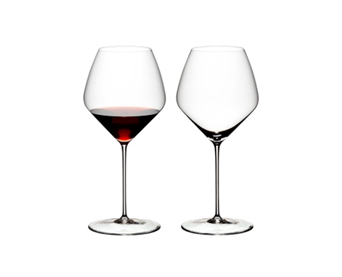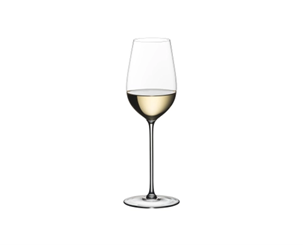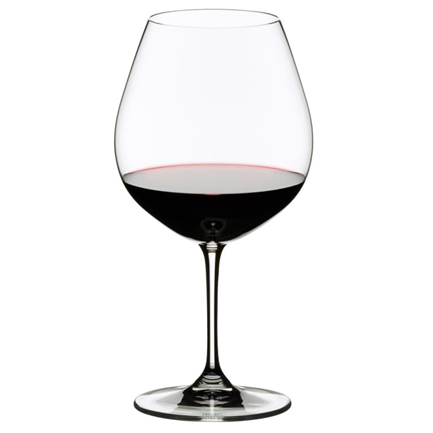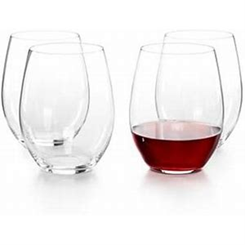Why Are There So Many Types of Wine Glasses? By Wine Aficionado and Founder of California Corks John Krause
Courtesy Riedel Wine Glasses
Have you been in the wine glass and accessories department recently? Did you happen to notice that there is a glass for nearly every type of wine you might decide to pour? The fact is, at first look it might be a challenge to look at all the options and wonder why so many choices. Let’s look at wine glass from A –to- Z as it were. We will review glasses you may just decide that you need for your favorite Sauvignon Blanc, Cabernet Sauvignon, Petite Sarah, or that Zinfandel you just purchased. After we have looked at the different shapes and sizes of wine glasses, I believe it will make a bit more sense.
According to the Court of Master Sommeliers there are nearly two dozen types of wine glasses available for serving wine today. That’s a lot of cabinet space dedicated to wine glasses! It’s a little surprise if you’ve recently browsed the glassware section of a home goods store. There are wide glasses and short glasses, tall and slender glasses — even funny-shaped glasses with special curved rims.
If you are someone that has pondered the question; “Why so many different wine glasses” you will discover that each size and shape of does matter in that each glass is designed specifically with the aim of enhancing the wines unique properties, flavors. The wine’s own characteristics if you will. Keep reading to explore our complete guide to the kinds of wine glasses and their uses, as well as the various wine glass shapes and purposes.
Red Wine Glasses
Often when someone says wine, one of the red varietals or a blend comes to mind. With that in mind, let’s look at some of the glasses designed for specific red wines. Red wines have more tannins so they need to be exposed to air so the wine will open, releasing its flavors and aromas. The larger bowl and opening of the glass ensure that the air to come into contact with more of the surface area of the wine in the glass. You can even enhance this by swirling the wine. That’s right, there is more to swirling the wine that just looks cool.
As you might have guessed there are several different red wine glasses varying in size and shape. You will find a wine glass is produced for Cabernet Sauvignon, Merlot, Pinot Noir, Zinfandel and even more. With the red wines a good thing to remember or keep in mind is to get the most out of the red wine you are tasting is to have a larger glass to expose the wine’s surface to the air. So, we begin to see how much importance a wine glass shapes the way for us to enjoy that Cabernet Sauvignon or another red wine.
Bordeaux Grand Cru - Courtesy Riedel Wine Glasses
What is the difference between Bordeaux and Burgundy Wine Glasses?
A Bordeaux glass is the tallest among the red wine glasses and have a broad bowl. Burgundy glasses have an even larger bowl than the Bordeaux with its narrow top. This design helps the drinker taste the nose of a Burgundy wine more effectively.
Pinot Noir/Nebbiolo Glass - Courtesy Riedel Wine Glasses
A Pinot Noir wine glass would be a Burgundy wine glass. The shape glass directs the wine more effectively for the one enjoying the glass to capture the boutique and taste of this wine. So much for red wine glasses for now. Let's take a look at wine glasses designed with one of your favorite white wines.
White Wine Glasses
Courtesy Riedel Wine Glasses
When serving white wines or rose wines medium size glasses are best to serve them in. Unlike a bold red wine, you want to keep the fresh fruit characteristics closer together and directed towards the top of the glass so when you sip, you’re sipping in the aromas as well. White wine glasses are designed to help you enjoy your white wine that much more. You don’t need to have a more open wine glass like red wines do. So, while can drink your white wine from about any kind of vessel, be good to yourself. Pull out some glasses, pour yourself and a friend, or friends a nice glass of wine, in the right glass.
Sparkling Wine Glasses
Just at the mention or sparkling wine or Champagne what do you picture with your mind’s eye? Likely right away up picture in your mind a Champagne Flute. For that special occasion a sparkling wine is probably the most important wine to serve in its specific glass, a tall, thin flute glass.
Why is that so? The reason is that the shape of the flute impacts the bubbles and the nose or aroma. Adding to the enjoyment of the wine is the face that you are having the more condensed glass, narrow and taller that allows the bubbles the winemaker put so much effort to achieve to “last or to live longer while you’re sipping that glass of bubbly. If sparkling wine is served in a larger glass, such as a glass you might use for a red wine such as a Cabernet Sauvignon, or a Pinot Noir, the bubbles burst too soon.
Still there are some wine lovers and enthusiasts that suggests serving sparkling wines in a larger wine glass is actually better than a flute. Why? because it helps the sparkling wine to open its aromas more. This may be true; however, the bubbles are lost – and before you know it - the thrill is gone. I find the sparkling wine goes flat much too quickly this way. I personally prefer the flute over the larger glass. Perhaps you might want to try it both ways to see which way you prefer to enjoy your sparkling wine.
Fortified Wine Glasses
Fortified wines are wines such as Port wine or a Port-Styled wine. You would also be perhaps pour a Brandy, or perhaps a Sherry. All the fortified wines such as Port wine, Brandy or Sherry are best served in small glasses, often referred to as dessert glasses. These types of wines are high alcohol, hence referred to as fortified wine. A smaller glass such as a dessert wine glass or fortified wine glass helps to emphasize the fruit in the wine rather than alcohol. A Port-Style wine is a dessert wine and a little goes a good way. Take small sips, my friend, tiny sips.
The Four Basic Characteristics of a Wine Glass
The rim
The rim is the very top of the glass, or the part that comes into contact with your lips as you drink. You may have heard the rim called the “mouth” of a glass. Thickness is the defining quality of wine rims. Why is that so? The thinner the rim, the easier and smoother wine sips.
The bowl
Wine glass bowls are the basin portion you pour the wine into. The wider the bowl, the easier it is to swirl your wine between and before sips. Remember wine swirling is not just for looks. When you swirl the wine in your glass the wine releases its own characteristic bouquet that may hide in a glass of still wine. With that in mind, go ahead and give you glass of wine a swirl that will result in a more complex taste.
The stem
Stems are the long, thin part of the glass drinkers hold without having to touch the bowl. Holding a glass by its stem preserves the wine’s serving temperature for the best possible tasting beverage.
The foot or base
The foot of a wine glass is the circular base allowing the stemmed wine glass to stand upright. The majority of glass types have this circular foot at the end of the stem. Unless you are using a stemless wine glass.
These four terms provide the basis for discussing different shapes of wine glasses. Together, the rim, bowl, stem, and foot affect how a wine swirls and sips, as well as its temperature regulation and the aromas we smell while drinking. These four parts are fundamental to understanding the reason for wine glass shapes, as well as what kind of glass to select when serving a particular wine.
General Overview of the Different Types of Wine Glasses
Today, there are dozens of wine glassware available to show off at your next blind tasting or dinner party. With that having been said, let’s explore the top wine glass types below, each with distinct design elements expressing the best from the wine from which it is served. Let's look at a few stemmed wine glasses.
The Bordeaux Glass
The Bordeaux wine glass is the perfect wine glass for us to begin describing the world of wine glassware. The Bordeaux Glass is taller than any other glass we can list. Bordeaux glasses have a comparatively longer stem and leaner, thinner bowl. The smaller, but longer, bowl lets wine travel directly to the back of your mouth and on your tongue. This shape is perfect for rich, full-bodied and mouth-coating red wines. A wine that might otherwise taste too sharp if they were to fill your entire mouth at once.
Burgundy Glass
Burgundy glasses carry much like the Bordeaux wine glass, yet the Burgundy glass contains a wider bowl. This fuller bowl is Burgundy’s signature characteristic, as well as a slightly shorter glass stem.
The result is that the shape of this wine glass makes room for softer, more fragrant and delicate red wines to shine. The larger bowl and easy-to-grasp stem allow drinkers to easily swirl their wine, unleashing flavors and aromas that may hide within the glassware. The bowl’s slope also means the wine will first hit the tip of your tongue before traveling to other areas, again leaving more room to highlight a wine’s more nuanced palates.
Cabernet Glass
Cabernet glasses are designed to focus and highlight the aromas of its wine. The wide, Burgundy-style bowls slope narrowly upward to create a small, tight rim without much room for natural air passage. Drinkers using a cabernet glass, therefore, experience a wine’s concentrated aromas first and foremost. The wide bowl still ensures proper aeration of the wine in the glass, with sips and smells funneled through the glasses narrow mouth.
Pinot Noir Glass
Pinot noir-style glasses are one of the most unique on this list. Among its key features are a wide, generous bowl and flared lips — in other words, a rim turned out slightly from the glass rather than smooth and straight. The wide bowl lets smoother reds gain the oxygen exposure needed to amplify the Pinot Noir's subtler flavors. The flared lips magnify its soft aromas as the glass directs the wine to the middle of your mouth.
Zinfandel Glass
Red zinfandel wines are a light-bodied, highly acidic varietal, creating a lush, bright and fragrant flavor profile. Unlike many other red wines, zinfandel also doesn’t need aeration before serving. That means glassware with smaller, leaner bowls are perfect for this red varietal. Overall, aim for zinfandel glassware that’s slightly shorter than other red wine glasses, with a slim bowl and average-sized rim.
Shiraz Glass
Consider Shiraz glasses, a cousin to the Cabernet. Like its cab comrade, shiraz glassware contains a wide, oxygen-trapping bowl and a tapered, slim rim funneling the beverage to the middle of your mouth. Sips from a shiraz glass balance the sharp tannins innate to the varietal sharing its name, while pushing concentrated fruit notes forward. Together, these features provide a more complex and well-rounded drinking experience for this full-bodied, dense red wine type that can be overpowering — even astringent — when mistreated.
Port Glass
Port wine is often among the popular dessert wines containing additional alcohol, typically in the form of fortified spirits. It gets its name from its homeland of Portugal, where this sweet beverage is a popular post-dinner aperitif.
Given port’s fortification and heavy, dessert-like palate, port wine glasses are shorter and stouter than other glassware. A proper port serving is three ounces, compared to the five-to six-ounce pours that are common for red and white wine. A dessert wine glasses, dedicated to port is a miniature version of the Bordeaux glass, with a smaller bowl proportionate to a small rim.
Sherry Glass
Sherry glasses are the smallest type on this wine glassware guide. Sherry glasses, designed specifically for the Spanish fortified wine carrying the same name, have a tiny, evenly proportioned bowl and a long stem, plus a small mouth. The stems are so long that they’re the same size as the rest of the body. This length keeps drinkers’ hands out of the way as they sip, maintaining optimal temperatures for the sweet dessert wine held within.
Chardonnay Glass
You’ll often hear chardonnay glassware referred to as the “universal” white wine glass. Its all-purpose design runs similar to the pinot noir glass, meaning it centers on a wide bowl and a tapered for a more concentrated rim. However, chardonnay glasses do not have flared lips, maintaining that classic U-shaped design resting on a medium-length stem. Chardonnay glasses will also be smaller in stature overall.
Chardonnay glassware is well-known for creating even, flavorful sips balancing earthy and fruity notes on the sides and tip of your tongue. It’s an excellent place to begin building your stemware collection, providing a versatile vehicle, particularly for dry white wines.
Fluted Wine Glass
Flutes are the quintessential glassware for all things bubbly. These slim, narrow glasses hold contents in a lean bowl, eschewing the traditional U-shaped design for a tall, slender glass with an equally long stem. The upright build retains carbonation better than any other glassware and is why flutes are the best choice for drinking your Champagne.
The slender flute also works like a charm for transferring delicate flavors straight to the tip of your tongue. It will enhance even young bottles of bubbly, though can mute more mature wines.
The glass’s curved shape still encourages carbonation to rise to the mouth continually. However, the wider bowl provides more oxygen, coaxing added nuanced flavors and aromas from its contents. For this reason, tulip-style glasses are best for aged or more mature “vintage” champagne bottles.
Stemless Wine Glasses
Many enjoy stemless glasses for their contemporary appearance. This style of wine glass is also easier to wash, as well as less prone to spills or tipping over. However, cons to stemless glasses are a natural byproduct of its design: Drinkers steadily transfer heat every time they clutch their glass, potentially altering the taste of their drink.
Rinsing a Glass with Some Wine
Sometimes when you’re in a tasting room you’ll see someone add a splash of wine in the glass and swirl, then dump the wine. This is done to clean the glass of any residue – soap, water minerals, etc. Remember too, if you are having a wine tasting, a small splash of the next wine to be tasted can be used to rinse the glass before tasting the next wine.
Are there Benefits of Matching THE RIGHT Glass with Wine Type?
Matching the appropriate wine glasses with the types of wine you are serving ensures the best possible tasting experience for you and your guests. That’s because the design of glasses for red, white, rosé or sparkling wine each highlight the following.
Appropriate temperature
Every wine varietal has an ideal serving temperature. As your general rule, it’s best to serve white wines chilled or semi-chilled, between 49- and 55-degrees Fahrenheit.
With most red wines you’ll want to serve the red wines at room temperature. Remember, room temperature can vary depending on who controls the thermostat. When you read or hear of someone mentioning serve at room temperature it means somewhere between 62- and 68-degrees Fahrenheit.
Correctly Aerated Wine
Certain types of red wines such as a bold like Barbera, Cabernet Sauvignon, a Petite Syrah and others particularly a tannin-heavy wine need exposure to the air before serving. This exposure to the air allows the wine to “breathe." Actually, the wine is oxidizing some of the chemical compounds that are in the wine to allow you to experience the full expression of its unique flavors.
Full Bouquet or Nose
Earlier in White Wine Glasses we mentioned a proper white or red glass permits appropriate wine aromas to escape. This sense of smell is instrumental in tasting. Without the wine breathing in the glass the aromas and bouquets would be missing, or at least diminished. As a result, you won’t be able to savor a glass of wine’s true virtues and flavors.
Artistic appeal:
Let’s face it! It’s fun to use pretty or decorative glassware. It’s even more fun to have a set of two to three types of wine glasses adorning your home bar cart or party drink station. Good food, good times, good wine, and good friends go together. Regardless of the situation, or wine your friends bring over, you’ll have an attractive, yet functional, set ready to go.
Additional Considerations
Investing in the right glassware to amplify the flavors of your favorite wines is essential. There are other details to consider when stocking your bar cart with wine ware, as well — details that save you time, space and money.
Storage space:
Let's face it. For the average wine-lover it isn't realistic to possess all types of wine glasses that have been designed to enhance every varietal you might decide to enjoy. Just imagine the space you would need. Picture an entire wall of cabinets dedicated exclusively to your collection of your cherished fine stemware!
Instead, pick two to three glass types made to complement the experience of enjoying the specific wines that have become to be among your favorites.
If wine is a casual, enjoyed at the dinner table, or relaxing around the house consider selecting a glass that will be the most versatile glass shapes. To get started, select two different wine glasses, one for your red wine, and one for those white wines you enjoy.
Budget:
Bargain hunters can shop for stemware sets containing a few types of versatile wine glasses — typically one type for red, one type for white and one for sparkling. When budget is your biggest concern, stick with these pre-packaged sets meant for a broad range of wines, rather than spiraling into the chase for every wine glass on the planet. Remember, a really good wine will still taste good regardless of the glass it is served in. If you still have your heart set on expanding your collection of wine glasses, you can add more exact pieces or glassware over time.
Get your favorite wine and the proper wine glass
Remember the reason you started to read this article? I hope you learned something new, or you were simply reminded that you are doing okay with the wine glasses you have on hand. Are you ready to put your new knowledge about all the different wine glasses to the test? There are plenty of glasses to choose from. In addition to purchasing at your favorite home store, you can browse online and have shipped right to your door by several wine glass manufactures in addition to fine vessels for cocktails and whiskies.
Are you ready to plan your next big dinner party or wine tasting? Be sure you don’t forget to use that your new glassware. Or clean up those glasses that have been gathering dust! Now that you have reviewed the many types of wine glasses perhaps now is the time to review some wine tasting tips that you just might find helpful.
About the Author: John Krause is wine enthusiast and the founder of the website California Corks, a directory of California wineries.

